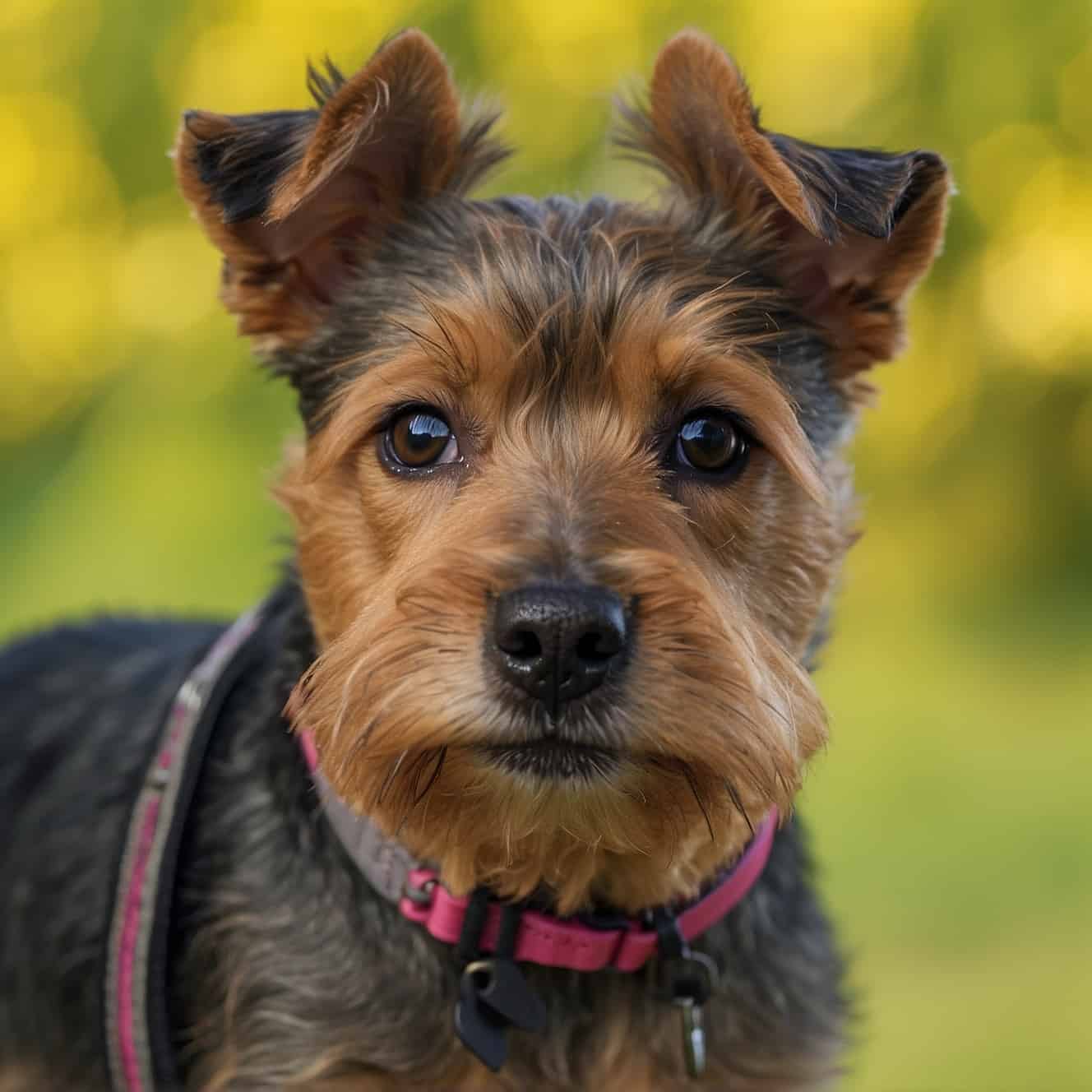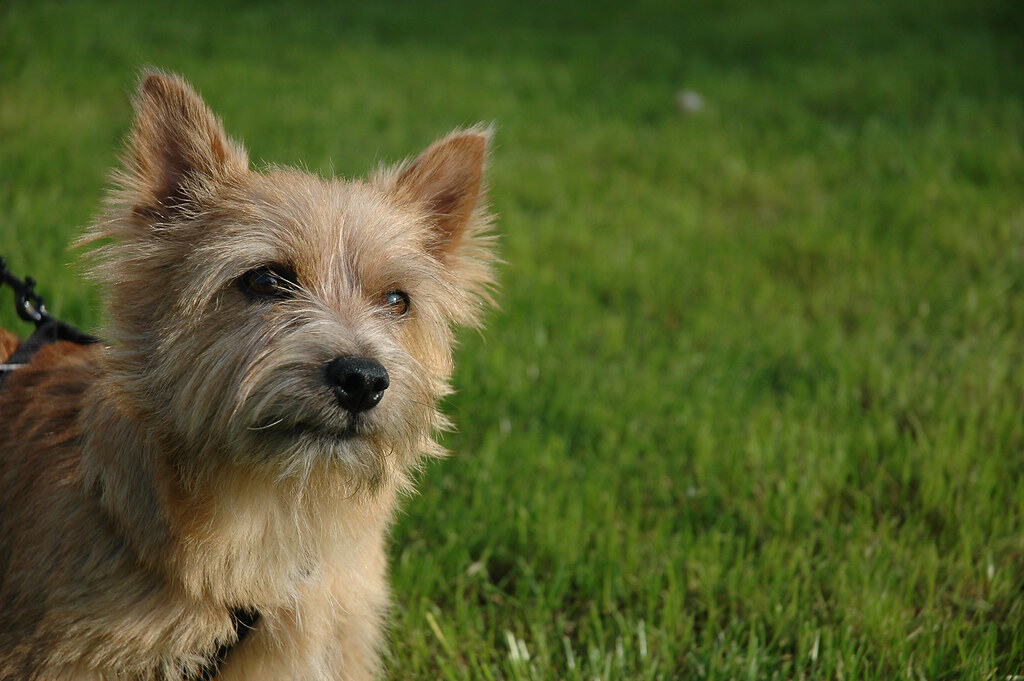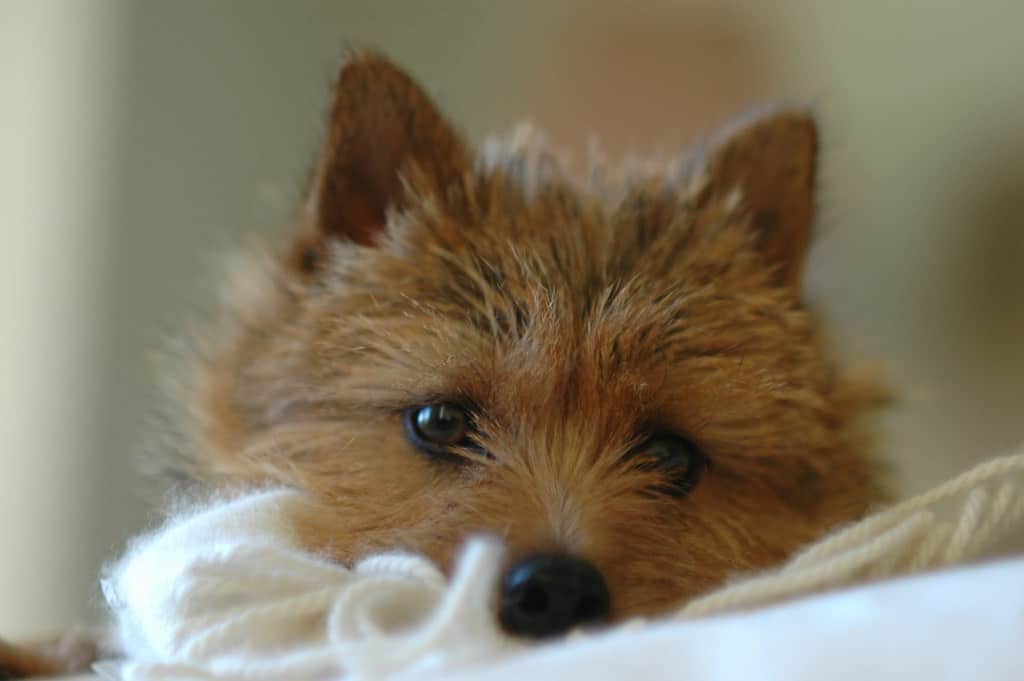Norwich Terriers share a history with their close cousin, the Norfolk Terrier, but have distinct characteristics and charm. Discover their unique attributes, explore their history, and understand the care that ensures their well-being as beloved family pets.

| Category (Explanation) | Breed Information |
|---|---|
| Year of Breed Conception | 19th century |
| Country of Origin | United Kingdom |
| Weight (lbs & kg) (Male) | 11-12 lbs (5-5.5 kg) |
| Weight (lbs & kg) (Female) | 9-10 lbs (4-4.5 kg) |
| Coat Type | Double coat, wiry outer coat |
| Color Variations | Red, wheaten, black and tan, grizzle |
| Shedding Level (Low, Moderate, High) | Low |
| Height (cm & in) | 9-10 inches (23-25 cm) |
| Breed Size | Small |
| Trainability (Low, Moderate, High) | Moderate |
| Mental Needs (Low, Moderate, High) | Moderate |
| Intelligence Level (Low, Moderate, High) | Moderate |
| Energy Level (Low, Moderate, High) | Moderate |
| Agility (Low, Moderate, High) | Moderate |
| Loyalty (Low, Moderate, High) | High |
| Playfulness (Low, Moderate, High) | High |
| Exercise Needs | Regular exercise and playtime |
| Guarding Proficiency (Low, Moderate, High) | Low |
| Sociability with Children (Low, Moderate, High) | High |
| Barking Level (Low, Moderate, High) | Moderate |
| Digging Tendency (Low, Moderate, High) | Moderate |
| Destructive Behavior (Low, Moderate, High) | Low |
| Drooling Level (Low, Moderate, High) | Low |
| Obedience Level (Low, Moderate, High) | Moderate |
| Apartment Friendly (Yes/No) | Yes |
| Inherent Prey Drive | Moderate |
| Physical Risk to Others (Low, Moderate, High) | Low |
| Travel Fatality Risk (Low, Moderate, High) | Low |
| Allergen Potential | Low |
| Health Concerns (List of Common Health Concerns) | Mitral Valve Disease, Patellar Luxation |
| Average Life Expectancy (Life Expectancy in Years) | 12-15 years |
Woof Mastery is reader supported and our articles may contain affiliate links.
Instead of running third party ads that we have no control of we only use links from high-quality companies we are directly partnered with. Making use of these links come at no cost to you our reader, and in many cases have the extra benefit of discounted rates or sign up bonuses.
If you’re interested you can read more about our affiliate policy here.
We appreciate your support and always insure that the products and services we recommend are high-quality, helpful and relevant to the subject at hand!
Norwich Terriers share a history with their close cousin, the Norfolk Terrier, but have distinct characteristics and charm. Originating in England, they were also bred to hunt vermin. The breed’s name, “Norwich,” refers to the town in England where they were recognized as a distinct breed. Norwich Terriers’ unique attributes, including upright ears, have made them distinctive. Their history as hunting dogs has transitioned into their modern role as beloved family pets, known for their lively and spirited personalities.

Norwich Terriers share a history with their close cousin, the Norfolk Terrier, but have distinct characteristics and charm. Their unique attributes and distinctive nature make them special. Explore their history, understand the care that ensures their well-being, and appreciate their individuality as beloved family pets. Norwich Terriers are special for their distinctiveness among terrier breeds.
Norwich Terriers share a history with their close cousin, the Norfolk Terrier, and their traditional role also relates to their origins as ratters. These small and feisty dogs were bred to hunt vermin, especially rats, in barns and stables in East Anglia, England. Their primary task was to keep these areas free of pests. Their distinctive appearance and energetic nature made them well-suited for this role. While their historical role as working dogs has evolved, Norwich Terriers continue to display their spirited and friendly characteristics as beloved family pets.
Norwich Terriers share distinct characteristics with their close cousin, the Norfolk Terrier. They have a unique and charming disposition. These terriers can be affectionate and make wonderful family pets. Proper training and socialization are essential to bring out their loving and unique qualities.
Norwich Terriers share a history with their close cousin, the Norfolk Terrier. They have distinct characteristics and charm. These dogs are typically affectionate and lively. However, they may retain some terrier stubbornness and independence. Early training and socialization can help them become well-behaved and friendly companions. Their small size makes them suitable for apartment living, provided they receive regular exercise.
Norwich Terriers share many physical characteristics with their cousin, the Norfolk Terrier. They are small dogs with a compact and well-proportioned body. They also have a dense, wiry, and straight coat that can come in various colors. Norwich Terriers have a small, round head with dark eyes, small V-shaped ears that stand erect, and a short tail. Their legs are short and sturdy, and they have an active, confident gait.
Norwich Terriers share coat colors with their close relatives, the Norfolk Terriers. They come in various shades, including red, wheaten, black and tan, or grizzle. Their dense, wiry coat may have subtle variations in shading or markings. The coat colors add to their charm and individuality, making them beloved family pets.
Norwich Terriers have a dense, wiry coat with similar color variations to Norfolk Terriers, including red, wheaten, black and tan, or grizzle. Their perky, erect ears are a notable feature of the breed.
Norwich Terriers have a low shedding level. They have a double coat with a soft, dense undercoat and a wiry topcoat. Regular grooming, including brushing, helps manage shedding and maintains the coat’s texture. While they shed minimally, attention to their grooming needs and occasional grooming sessions contribute to reduced shedding. Overall, Norwich Terriers are considered to be a breed with low maintenance in terms of shedding.
Norwich Terriers have a wiry, weather-resistant coat that requires regular grooming to maintain its quality.
Brushing: Regular brushing, 2-3 times a week, helps remove loose hair and prevents matting. Use a slicker brush or a comb suitable for their coat.
Stripping: Norwich Terriers may require hand-stripping to maintain the texture of their coat. This can be done by a professional groomer.
Bathing: Occasional baths, using a mild dog shampoo, help keep the coat clean. Thoroughly rinse and dry after the bath.
Ears: Regularly check and clean their ears to prevent wax buildup or infections. Use a damp cotton ball or a veterinarian-recommended ear cleaning solution.
Nails: Keep their nails trimmed to a comfortable length, as long nails can cause discomfort and affect their gait.
Teeth: Brush their teeth regularly to maintain good oral hygiene. Dental chews or toys can also be beneficial.
Eye Care: Monitor their eyes for signs of irritation or discharge. Clean the eye area with a damp cloth if necessary.
Norwich Terriers have a moderate to high activity level. These small terriers are energetic and enjoy regular exercise. Daily walks, playtime, and interactive toys can help meet their activity needs. Norwich Terriers thrive on mental stimulation, so engaging them in training sessions and providing puzzle toys can keep them happy and mentally sharp.
Norwich Terriers are known for their intelligence, marked by problem-solving abilities, adaptability, and a desire to please their owners. They are generally trainable and responsive to positive reinforcement training methods. Norwich Terriers can learn various commands and tasks. Their adaptability allows them to thrive in different living environments. Historically, they were skilled in roles such as hunting and vermin control, showcasing social intelligence by forming strong bonds with their families. While they may not top the charts in terms of obedience, their intelligence makes them excellent companions and working dogs. Training, socialization, and mental stimulation contribute to their well-rounded and obedient nature.
Norwich Terriers benefit from mental stimulation through activities like puzzle toys and obedience training. Keeping their minds active helps prevent boredom.
Social Interaction: They are social dogs and enjoy spending time with their human family. Regular companionship and attention contribute to their mental well-being.
Exercise: Engaging in physical activities, such as walks and play, is important for their mental health and helps prevent behavioral issues.
Enter The Woof Mastery

Prospective owners of Norwich Terriers should be ready for a spirited and affectionate companion. Regular exercise and mental stimulation contribute to their well-being. Grooming their wiry coat is essential for maintaining its condition. Norwich Terriers are known for their lively and confident nature, so early training and socialization are crucial. Potential health concerns should be monitored with regular veterinary check-ups. A loving and engaging environment is key to ensuring the happiness and well-rounded behavior of these delightful dogs.
Norwich Terriers, known for their playful and affectionate nature, generally pose a low risk to others. Proper socialization and training contribute to positive interactions. Responsible ownership, understanding individual temperament, and adherence to local regulations play crucial roles in ensuring a well-behaved Norwich Terrier.
Norwich Terriers can be good with children, especially when properly socialized. Supervision is important during play, and positive reinforcement training helps ensure positive interactions. Teaching children how to approach and handle the dog contributes to a positive relationship.
Norwich Terriers may have mixed responses to water. Some individuals may enjoy swimming, while others may not be as comfortable. If you plan to introduce them to water, do so gradually and observe their comfort level. Always prioritize safety and use a canine life vest if needed, especially in situations where they may be at risk of fatigue.
Remember that Norwich Terrier puppies, like all puppies, are eager to please and learn. Positive and consistent training practices will help them become well-behaved, obedient, and happy adult dogs. Building a strong and trusting bond with your puppy through training is a rewarding experience for both you and your canine companion.
Norwich Terriers are known for being alert and may bark to alert their owners or express themselves. While they can be vocal, excessive barking is not a common trait. Proper training and socialization contribute to a well-behaved and appropriately vocal Norwich Terrier.
Norwich Terriers are adaptable and can live in various environments. They do well in homes with yards for play, but they can also adapt to apartment living with sufficient exercise. Regular walks and mental stimulation contribute to their well-being. Norwich Terriers enjoy socializing with their family and thrive on companionship. Early training helps in shaping their behavior positively.
Norwich Terriers are generally adaptable to travel conditions. Ensure they are securely restrained in the vehicle using a crate or a suitable seatbelt harness. Monitor for signs of stress or discomfort and provide breaks for exercise. Familiar items and positive reinforcement can contribute to a positive travel experience for Norwich Terriers. Plan for regular breaks during long journeys to ensure their well-being.
Norwich Terriers may be prone to specific health concerns, and while not all individuals will experience these issues, it’s important for owners to be aware of potential risks. Common health concerns in Norwich Terriers include:
Regular veterinary check-ups, a balanced diet, proper dental care, and regular exercise can contribute to the well-being of Norwich Terriers. Owners should monitor their dogs for any signs of health issues and seek veterinary care as needed.
Proper nutrition is essential for Norwich Terriers to maintain their health and well-being. Consider the following nutritional habits and best practices for this breed:
Breed-Specific Laws (BSL): Norwich Terriers may be subject to breed-specific laws (BSL) in certain areas. These laws are often enacted at the local or municipal level and can vary widely from one jurisdiction to another.
Types of Restrictions: The specific restrictions imposed on Norwich Terriers under BSL can include mandatory spaying/neutering, special licensing, liability insurance requirements, muzzling in public, and, in some cases, bans on ownership. The severity of these restrictions depends on local regulations.
Rationale for BSL: BSL is typically implemented based on concerns about public safety and perceived risks associated with specific breeds, often due to incidents involving dog attacks. While Norwich Terriers are not inherently aggressive, they can be affected by BSL due to their physical resemblance to breeds that are sometimes included in these laws.
Controversy: It’s important to note that BSL is a controversial topic. Critics argue that it unfairly targets breeds rather than addressing individual dog behavior and that responsible ownership and training should be emphasized instead of breed-specific restrictions.
Local Regulations: To determine if there are breed-specific laws or restrictions regarding Norwich Terriers in your area, you should check with your local animal control or government authorities. Be aware of and comply with any local regulations to ensure that you are in compliance with the law while owning a Norwich Terrier.
Woof Mastery is reader supported and our articles may contain affiliate links.
Instead of running third party ads that we have no control of we only use links from high-quality companies we are directly partnered with. Making use of these links come at no cost to you our reader, and in many cases have the extra benefit of discounted rates or sign up bonuses.
If you’re interested you can read more about our affiliate policy here.
We appreciate your support and always insure that the products and services we recommend are high-quality, helpful and relevant to the subject at hand!
Myth 1: Norwich Terriers are High-Maintenance Grooming Dogs
Myth 2: They are Fragile and Delicate
Myth 3: Norwich Terriers Don’t Get Along with Other Pets
Myth 4: They Require Minimal Exercise
Myth 5: Norwich Terriers are Not Good with Children
These myths underscore the importance of understanding Norwich Terriers’ characteristics and providing them with the care, training, and socialization they require for a happy and healthy life.
Famous Norwich Terrier owners include:
The Norwich Terrier is culturally significant for its lively and affectionate nature. With a distinctive appearance, including pointed ears and a fox-like expression, Norwich Terriers have found their way into the hearts of dog enthusiasts. Their role as affectionate companions and, at times, in media appearances has added to their cultural appeal.
The Norwich Terrier, known for its lively and affectionate nature, does not have a single most famous historical owner. However, Norwich Terriers have been appreciated for their spirited personality and charming appearance.
Norwich Terriers, similar to Norfolk Terriers, face challenges associated with their size and specific breed characteristics:
The Norwich Terrier, like the Norfolk Terrier, is a small terrier breed with a lively personality. It shares common ancestry with various terrier breeds, contributing to its traits. The contributing breeds include:
Norwich Terriers, with their adorable appearance and affectionate nature, make cherished family companions. Known for their loyalty and adaptability, they seamlessly integrate into various living conditions. Their moderate grooming needs and manageable size make them suitable for families. Norwich Terriers excel in activities and training, showcasing their agility and enthusiasm. Their affectionate disposition and compatibility with children make them valued additions to households seeking a playful and devoted companion.